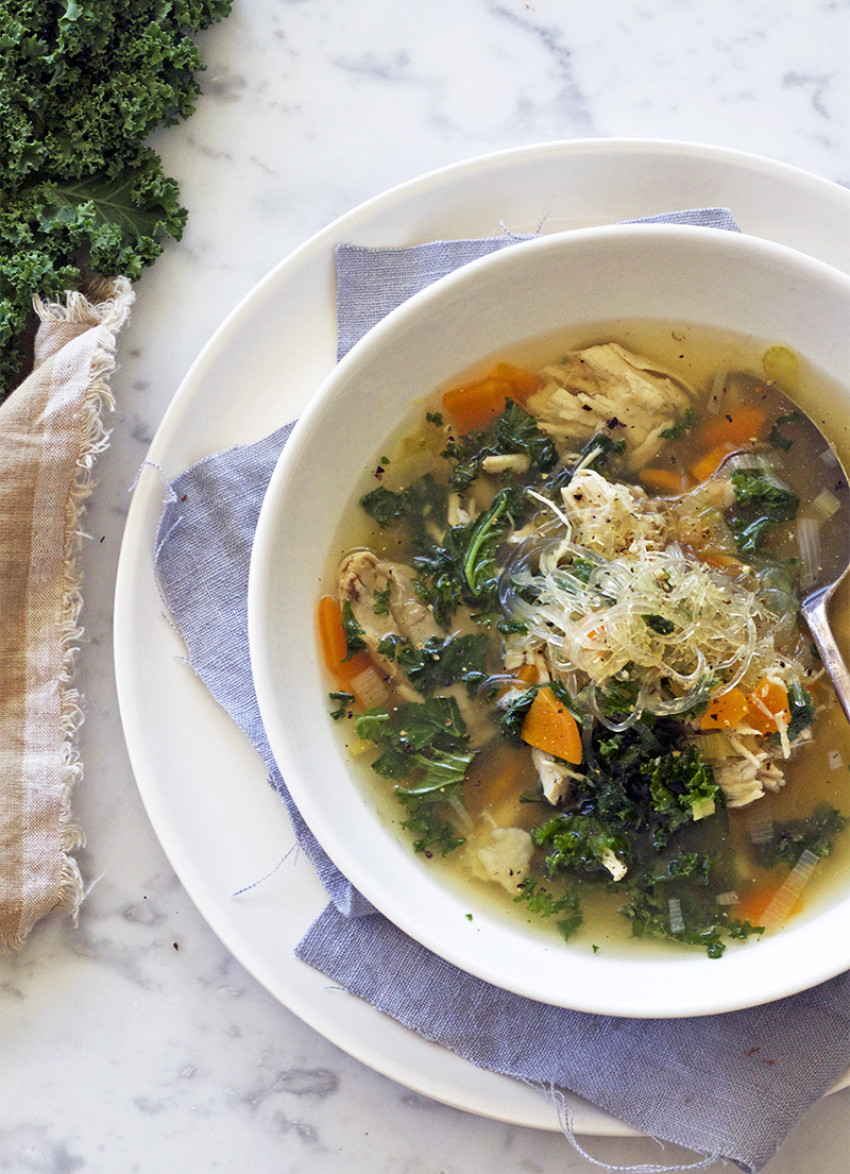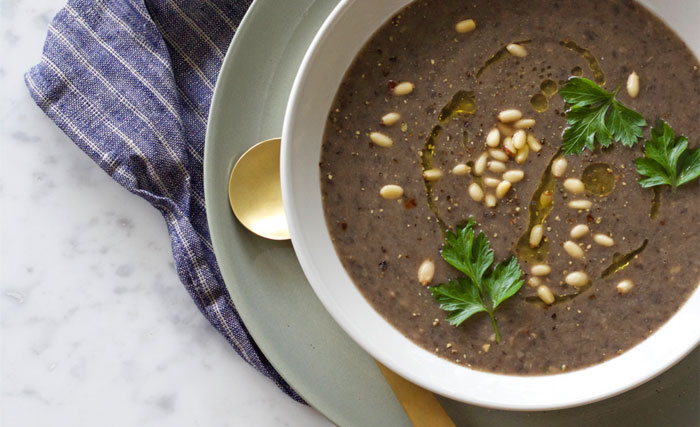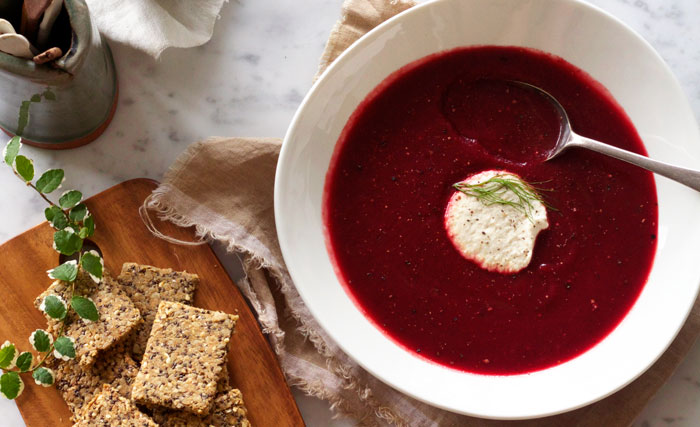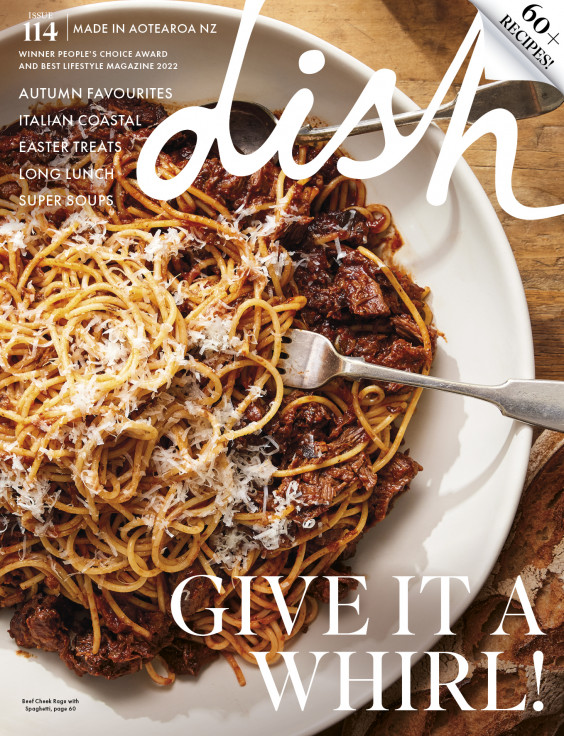A guide to: Making broths and stocks
Photography by Kelly Gibney.

Once the colder months hit, my kitchen is home to a broth-making session at least once a week. I absolutely love having this staple ingredient at my fingertips whenever I need it.
While it’s very easy to buy ready-made stock from the supermarket, you’ll find it hard to go past the health benefits and satisfaction that comes from crafting a delicious, rich bone broth from meat bones or a tasty homemade vegetable stock. Doing away with needless packaging and making good use of vegetable scraps are just some of the things I love about going the homemade route.
Bone Broth
Rather than a newly discovered, mystical superfood ingredient, this is traditional food making at its most basic. The process of boiling bones for as little as four hours, or as long as 48, with a little cider vinegar is said to release collagen, glycine and a host of vitamins and minerals. All are beneficial for joint, bone and gut health as well as overall wellbeing. The foundation of your stock will, of course, be the bones. There are two options: either use some from meal leftovers or source from your local butcher. For the former, a roast chicken carcass is the most obvious but I also collect smaller bones like leftovers from lamb shoulder or neck chops, chicken wings or drumsticks. Simply store in the freezer – a zip lock bag is ideal – until you have enough to make stock.
Ingredients
1 kilogram bones or 1 chicken carcass (aim to have some marrow bones in there if making beef/lamb broth)
3 cups (roughly) vegetable scraps or 1 onion, cut into quarters
2 carrots, sliced
3 stalks celery, roughly chopped
Plus
4 cloves garlic
1 bay leaf (optional)
handful parsley stalks (optional)
6–8 litres water
4 tablespoons apple cider vinegar
Method
If the bones or carcass are raw, roast in the oven for 25 minutes at 180°C. This will add a lovely depth of flavour to the end product.
Place your bones, vegetables, herbs and water in a very large pot. Add the cider vinegar. Bring to a boil. Reduce to simmer for 4–8 hours, skimming any brown foam from the top periodically.
Alternatively, bring to a boil and then pour into a slow cooker to cook on low for 2 days. Strain stock through a fine sieve and set aside to cool for 20 minutes. Use a muslin-lined sieve if you want a clear broth.

Vegetable Stock
Homemade vegetable stock is so simple. Truly. You’ll wonder why you ever bought it. It’s the perfect way to use up vegetables that have wilted beyond being used. Things like the green part of the leeks, garlic, carrot and zucchini tops are all great. So are fennel, parsnips, potatoes and mushroom stems. Collect your vegetables scraps in a zip lock bag in the freezer. Once it’s full, you’re ready to make a batch of stock. The trick of adding prunes to vegetable stock is something I learned from Yotam Ottolenghi’s book Plenty. It sounds unusual but it adds a wonderful flavour.
Ingredients
large zip lock bag of vegetable scraps OR
3 carrots, roughly chopped
2 brown onions, cut into quarters
4 celery stalks, cut into chunks
1 small bulb fennel, halved
Plus
8 cups water
4 cloves garlic
1 teaspoon whole peppercorns
1 bay leaf
small handful of fresh thyme leaves or 3 stems fresh rosemary 6 prunes (optional)
Method
Place all stock ingredients into a large soup pot and bring to the boil. Reduce to a simmer and cook for 60–90 minutes.

Stock Tips
If the smell of bone broth simmering in your kitchen is a little overpowering (beef bones are quite strong) add parsley stalks every couple of hours. I find them effective as an odour neutraliser.
- Cooled bone broth will have a solid layer of fat on top. You can simply remove and discard or be very waste-free and use it instead of your usual oil when sautéing.
Stock can be frozen for up to 6 months. Thawed stock should be used within 3–4 days.
- No need to worry about thawing frozen vegetable scraps beforehand. The vegetables will defrost fast while bringing the stock to a boil.
In general the best vegetables to use are: onions (the skins give chicken stock their lovely golden colour), carrots, garlic, zucchini, celery, green beans, capsicums and leeks. It’s probably best to avoid beetroot, broccoli and cauliflower – their flavour or colour (in the case of beetroot) is too overpowering.
Decant the stock into different sized containers that will best serve how you will be using it. Freeze some big portions for soup and risotto and also smaller amounts for adding to dishes like bolognese, adding flavour to rice dishes and for deglazing the pan.
I find clean peanut butter jars a great way to store stock. They fit perfectly in the door of my freezer. Just leave an inch of space at the top to allow for the liquid expanding.
latest issue:
Issue #114
Autumn has arrived, and with it, the latest issue of dish, jam-packed with recipes that will have you fizzing to get in the kitchen! With a long Easter lunch featuring perfectly pink, blushing roast leg of lamb and wildly decadent baked mashed potatoes with caramelised onions, to simply scrumptious chocolate treats and sensational seasonal baking this issue has you covered - we reckon the Hot Cross Buns are our best yet! Salads make way for soothing soups, pies, puddings and our cover star beef cheek ragù with spaghetti – a must-make dinner for family and friends. With over 60 recipes in our latest issue there’s plenty of inspiration to keep you busy – and well-fed! Don’t forget to share your dish dishes with our Facebook community.

